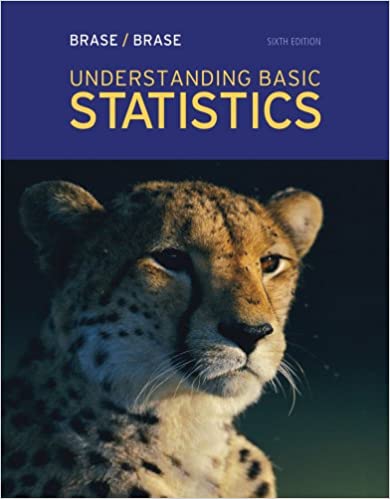
Understanding Basic Statistics 6th Edition by Charles Henry Brase,Corrinne Pellillo Brase
Edition 6ISBN: 978-1111827021
Understanding Basic Statistics 6th Edition by Charles Henry Brase,Corrinne Pellillo Brase
Edition 6ISBN: 978-1111827021 Exercise 5
Provide the following information
(a) What is the level of significance State the null and alternate hypotheses.
(b) Check Requirements What sampling distribution will you use Do you think the sample size is sufficiently large Explain. Compute the value of the sample test statistic.
(c) Find the P -value of the test statistic. Sketch the sampling distribution and show the area corresponding to P -value.
(d) Based on your answer in part (a) to (c), will you reject or fail to reject the null hypothesis Are the data statistically significant at level
(e) Interpret your conclusion in the context of the application.
Focus Problem: Beford's Law Please read the Focus Problem at the beginning of this chapter. Recall that Beford's Law claims that numbers chosen from very large data files tend to have "1" as the first nonzero digit disproportionately often. In fact, research has shown that if you randomly draw a number from a very large data file, the probability of getting a number with "1" as the leading digit is about 0.301 (see the reference in this chapter's Focus Problem).
Now suppose you are an auditor for a very large corporation. The revenue report involves millions of numbers in a large computer file. Let us say You took random sample of n = 215 numerical entries from the file and r = 46 of the entries had a first nonzero digit of 1. Let p represent the population proportion of all numbers in the corporate file that have a first nonzero digit of 1.
i. Test the claim that p is less than 0.301. Use = 0.01.
ii. If p is in fact less than 0.301, would it make you suspect that there are not enough numbers in the data file with leading 1's Could this indicate that the books have been "cooked" by "pumping up" or inflating the numbers Comment from the viewpoint of a stockholder. Comment from the perspective of the Federal Bureau of Investigation as it looks for money laundering in the form of false profits.
iii. Comment on the following statement: "If we reject the null hypothesis at level of significance , we have not proved H 0 to be false. We can say that the probability is that we made a mistake in rejecting H 0." Based on the outcome of the test, would you recommend further investigation before accusing the company of fraud
(a) What is the level of significance State the null and alternate hypotheses.
(b) Check Requirements What sampling distribution will you use Do you think the sample size is sufficiently large Explain. Compute the value of the sample test statistic.
(c) Find the P -value of the test statistic. Sketch the sampling distribution and show the area corresponding to P -value.
(d) Based on your answer in part (a) to (c), will you reject or fail to reject the null hypothesis Are the data statistically significant at level
(e) Interpret your conclusion in the context of the application.
Focus Problem: Beford's Law Please read the Focus Problem at the beginning of this chapter. Recall that Beford's Law claims that numbers chosen from very large data files tend to have "1" as the first nonzero digit disproportionately often. In fact, research has shown that if you randomly draw a number from a very large data file, the probability of getting a number with "1" as the leading digit is about 0.301 (see the reference in this chapter's Focus Problem).
Now suppose you are an auditor for a very large corporation. The revenue report involves millions of numbers in a large computer file. Let us say You took random sample of n = 215 numerical entries from the file and r = 46 of the entries had a first nonzero digit of 1. Let p represent the population proportion of all numbers in the corporate file that have a first nonzero digit of 1.
i. Test the claim that p is less than 0.301. Use = 0.01.
ii. If p is in fact less than 0.301, would it make you suspect that there are not enough numbers in the data file with leading 1's Could this indicate that the books have been "cooked" by "pumping up" or inflating the numbers Comment from the viewpoint of a stockholder. Comment from the perspective of the Federal Bureau of Investigation as it looks for money laundering in the form of false profits.
iii. Comment on the following statement: "If we reject the null hypothesis at level of significance , we have not proved H 0 to be false. We can say that the probability is that we made a mistake in rejecting H 0." Based on the outcome of the test, would you recommend further investigation before accusing the company of fraud
Explanation
(a)
b)
We use the sampling distribut...
Understanding Basic Statistics 6th Edition by Charles Henry Brase,Corrinne Pellillo Brase
Why don’t you like this exercise?
Other Minimum 8 character and maximum 255 character
Character 255


